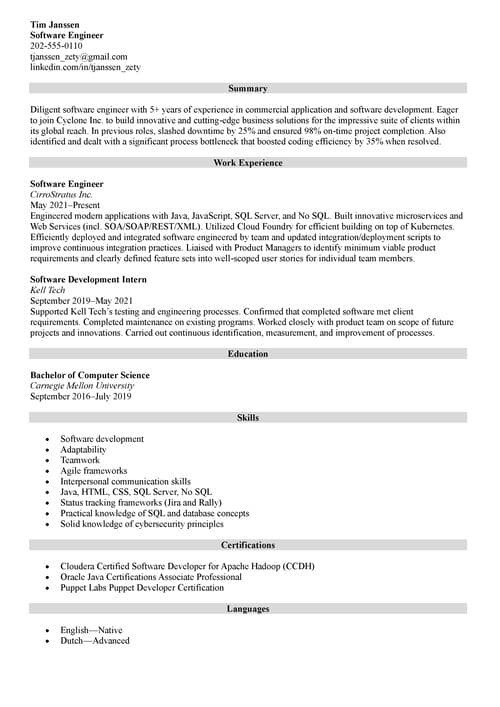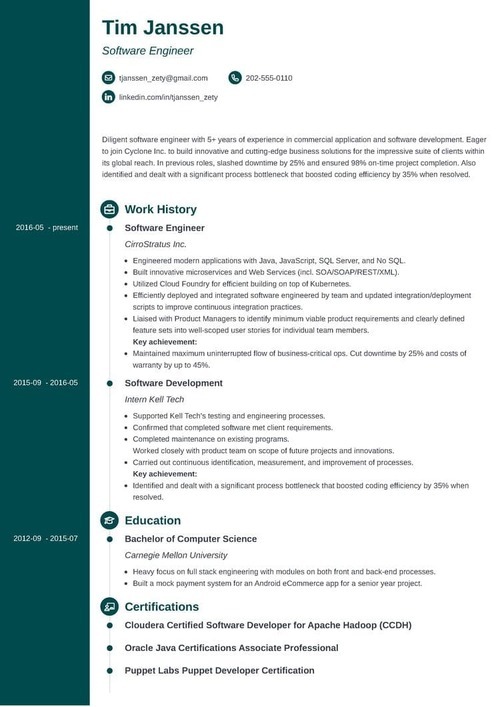
How to Introduce Yourself Professionally & Casually—Examples
Say hi. Say your name. Scratch your head. And... Hope for someone else to take it from there. Let’s be honest: It’s not exactly how you want to introduce yourself. That’s why you’re here.
This guide will show you:
- Why you have to know how to introduce yourself well in different contexts.
- How not to introduce yourself.
- What are the best ways to introduce yourself in a job interview or an email.
Want to save time and have your resume ready in 5 minutes? Try our resume builder. It’s fast and easy to use. Plus, you’ll get ready-made content to add with one click. See 20+ resume templates and create your resume here.
Sample resume made with our builder—See more resume examples here.
Looking for other ideas? Read our guides on:
1
How Not to Introduce Yourself
Before we move on any further—
Let me introduce myself.
“My name is Maciek. And I like Hawaiian pizza.”
Eek!
Not great, right? (And it’s not exactly because of pineapple on a pizza.)
Truth is—
While this way to introduce myself may be funny to some, the vast majority will find it plain stupid.
And this is exactly how most people mess their intros up.
By introducing themselves in ways that are irrelevant to the larger context.
2
How to Introduce Yourself Professionally
Here’s the thing:
You never get a second chance to make a first impression.
But—
Give me a second chance so you don’t ever need it.
Professional Introduction—Example
| GOOD |
|---|
| My name is Maciek, and I’m a career writer. My job is to provide job seekers with expert advice on career-related topics. I read a lot and consult recruiting professionals so you don’t have to. I show you how to hack the recruitment process, create a job-winning resume, ace the job interview, and... introduce yourself, among others. |
Better, right?
Now—
When you come to think of it, the first self-introduction wouldn’t have sucked that much in a meeting of Italian cuisine chefs.
In fact, it might’ve been a good one.
But not in the context of this article. Such a professional introduction doesn’t make sense, and it’s not useful in the least.
Remember:
Relevance is key when you introduce yourself. In a speech, writing, to a group, or in any other context.
So, in a professional context, follow the below steps:
How to Introduce Yourself Professionally—Dos and Don’ts
- Make your professional introduction relevant.
You may be a pizza lover, but unless you’re a chef or taking part in a culinary workshop, it will feel cute random. Be mindful of the context.
- Go beyond your professional title.
The truth is, job titles don’t mean much. Sorry. The best way to introduce yourself is to explain what your job is really about.
- Say what your contribution is.
This ties in nicely with the previous point. But it’s just so important it deserves a separate point. Your professional introduction should tell the audience about your contribution to their (professional) lives. What problems do you help them solve?
- Be original.
It doesn’t mean that if you’re a writer you need to prepare a self-intro essay. No. Just take an extra step and say something more about the nature of your job. Plus, the way you deliver your professional introduction matters. You know, a friendly smile works magic.
- Prepare.
No ideas on how to make a great introduction? Take a step back and ask yourself what you want to be known for.
- Mind the cultural context.
If you’re introducing yourself to an international audience, make sure not to offend anybody.
- Be careful when coming up with funny ways to introduce yourself.
Humor is great, but avoid cracking jokes for the sake of cracking jokes. What you consider funny may not resonate with your speaker.
One more thing.
Sometimes, it may be very hard to say anything more than your typical “I’m a project manager,” “I’m a teacher,” “I’m a scientist.” It’s especially true when you’ve been doing your thing for a long time.
That’s where your friends and family come in.
Just ask them to help you figure out what your real contribution is.
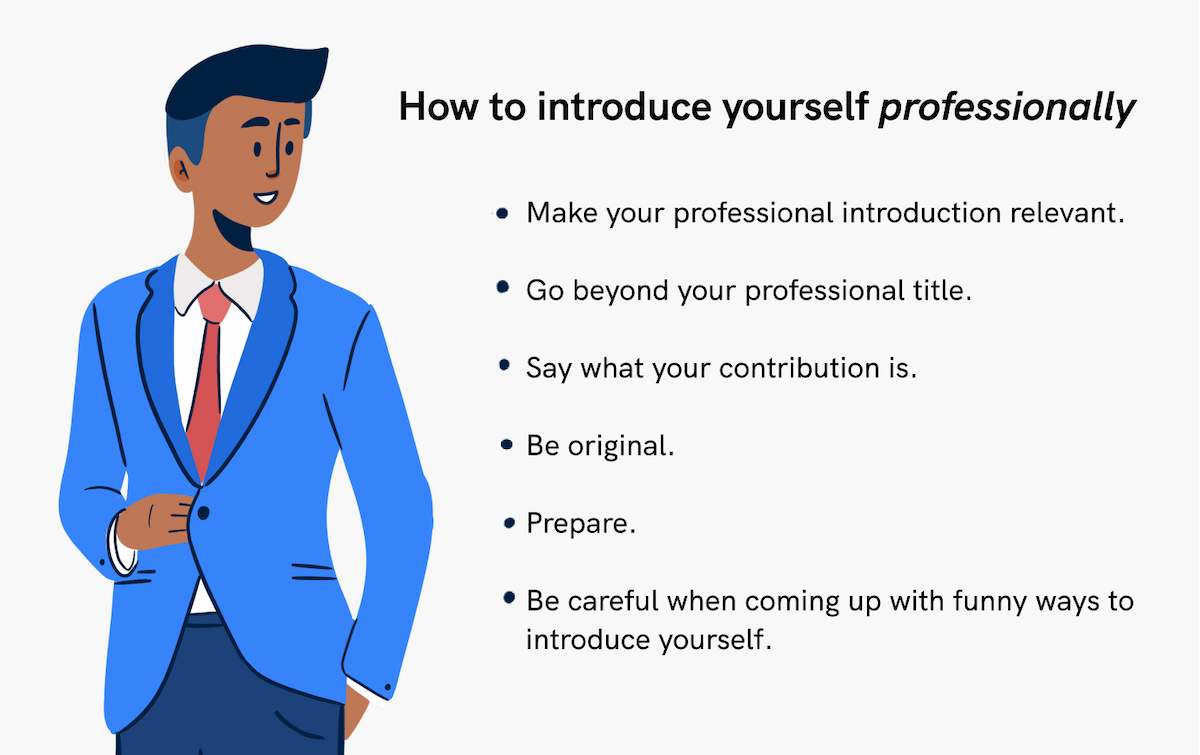
3
How to Introduce Yourself in an Interview
Here’s the thing.
A good job interview introduction is essentially the same as answering the “tell me about yourself” question.
In fact—
We have a dedicated guide on how to answer “tell me about yourself” question, so let’s just stick to the basics here.
To Introduce Yourself in a Job Interview:
- Mind the context.
It’s a bit of a no-brainer. The context is your job interview, and introducing yourself means giving the best answer to “tell me about yourself” question.
- Do your research.
To introduce yourself in the best possible way, find out as much as you can about the company you’re applying to. Make sure you’re a cultural fit. And learn how to answer them what are you passionate about question.
- Control your body language.
Body language communicates much more than you think. When you introduce yourself to the recruiter:
- Look them in the eye.
- Make sure your handshake is firm but natural to signal trust.
- Speak with confidence.
- Do not fidget, roll up your eyes, or cross your arms.
- Prepare your answer.
Come in prepared to deliver the best interview introduction. That’s it. Rehearse what you want to say to minimize the chances of being taken by surprise.
Follow our successful interview tips. There’s much more to acing the interview than knowing how to introduce yourself to a recruiter.
And remember:
It’s not how you start. It’s how you finish.
So—
Learn how to write a thank you email after an interview.
When making a resume in our builder, drag & drop bullet points, skills, and auto-fill the boring stuff. Spell check? Check. Start building a professional resume template here for free.
When you’re done, Zety’s resume builder will score your resume and tell you exactly how to make it better.
4
How to Introduce Yourself in an Email
Just think about it:
Before you even get a chance to introduce yourself in an interview, you need to land one.
In this day and age sending a job application via email is the way to go.
So—
Whoa!
Let’s stop here before it gets worse.
With an introduction like that, the only person concerned... would be yourself.
Luckily, we have a series of in-depth articles that—
Show you how to introduce yourself in an email for a job application:
Offer step-by-step guidance on how to introduce yourself in a cover letter:
- How to Address a Cover Letter
- How to Start a Cover Letter
- How to Write a Cover Letter
- How to End a Cover Letter
Explain how to introduce yourself in a cover letter email:
Remember:
A successful introduction goes beyond a single sentence or paragraph.
It’s the entire message that counts.
For detailed advice, head straight to one of our dedicated guides listed above. To make sure your introduction email is complete consult the checklist below:
How to Introduce Yourself in an Email to a Recruiter—Checklist
- Include all email elements.
This may seem obvious, but double-check if your message starts with a subject line and ends with your name. Your “introduce yourself” email cannot be incomplete.
- Write a great subject line.
When you introduce yourself via email the last thing you want is to land in a spam folder. Come up with a strong subject line. Stay within the suggested character limit. Avoid spam trigger words. If you’re replying to a job offer, make sure you use the right subject format.
- Choose an appropriate greeting.
In an email to introduce yourself, “dear Sir or Madam” looks lazy. It shows you don’t know who you’re writing to. Make an effort to identify your Dear Sir or Madam by name.
- Craft a great opening sentence.
It sets the tone for everything you want to include in your self-introductory email.
- Offer the context. Say why you’re writing.
Relevance is key. A message that doesn’t resonate with the recipient will go straight to the trash folder. You don’t want your introduction email to a recruiter to go there.
- Make your offer. Ask for something.
Show the hiring manager how they will benefit from hiring you, and ask for an interview. This is the most important part of your entire professional introduction.
- Say thank you.
Ending your self-introductory email with gratitude can boost your chances of getting a reply. Read this study to find out more.
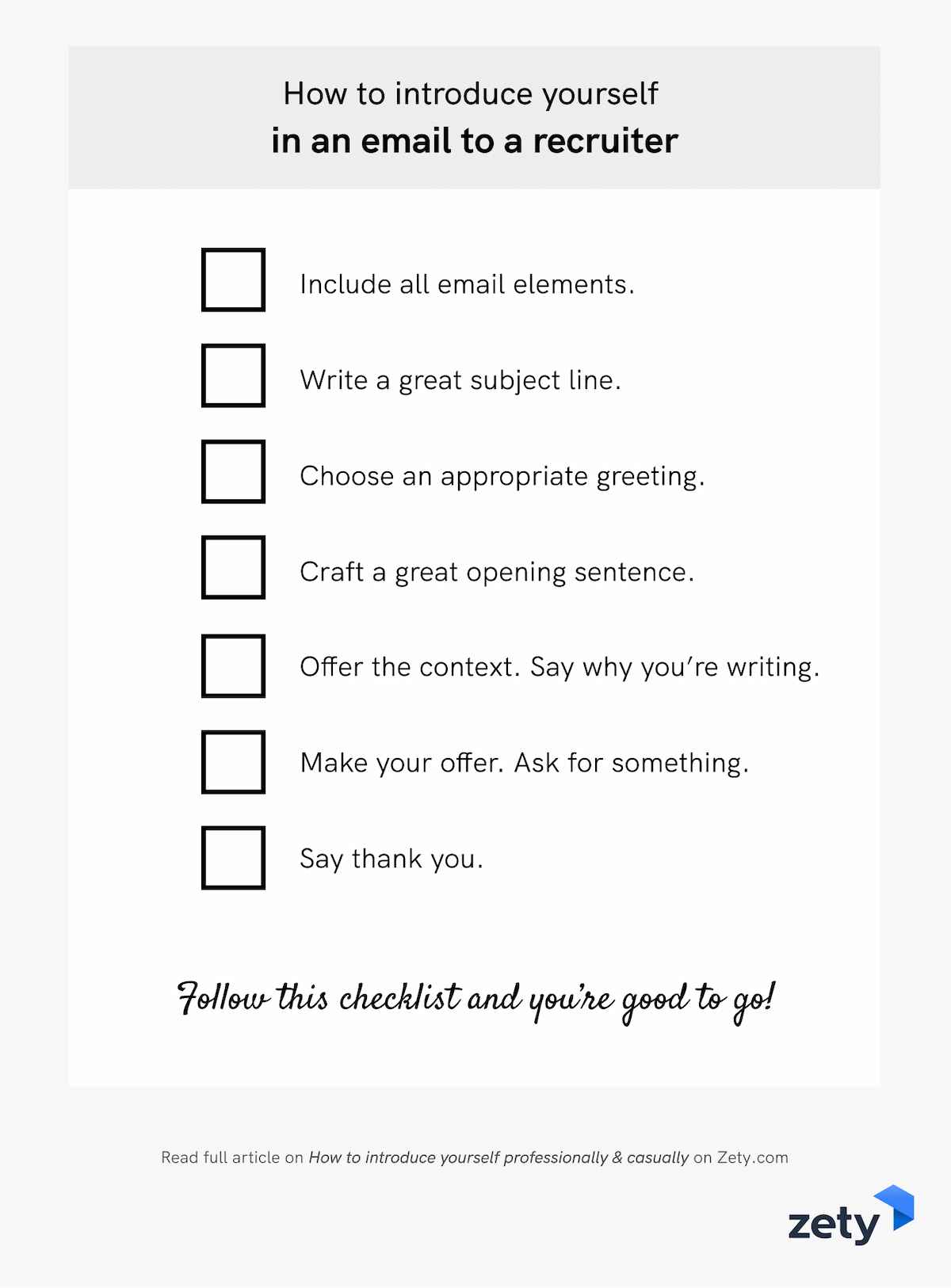
Now, let’s move on to—
New Employee Self-Introduction Email
A successful introductory email to a recruiter is not the end of story.
Because—
You’re likely to come across other situations when you’ll have to introduce yourself via email or in writing.
Look at these typical challenging tasks of a new employee:
- Send an introduction email to the new team
- Write an introduction paragraph about yourself for the newsletter
- Prepare an “about me” paragraph for the website
Don’t panic.
You already know the most important thing: the context.
Plus—
You’re not the first person tasked with this.
Ask your teammates to show you their “about me” sample text. This will give you a first-hand insight into the length, structure, and tone expected of you.
If you have no reference point for your new employee self-introduction email, paragraph, or blurb—
Imagine you’re talking to a real person. Write down the introduction paragraph about yourself just the way you would normally introduce yourself professionally.
Simple as that. Look at this example:
How to Introduce Yourself to a New Team—Email Sample
Hi!
My name’s John. I’ve just joined the marketing department as an outreach specialist.
I’ll be getting in touch with influencers, bloggers, and vloggers to increase our online presence.
If you see a new face around, well, that’s me:) We can chat about cyberpunk literature, video games, and downhill mountain biking.
Cheers!
John
PS The sweet treats in the kitchen are all for you!
Remember:
Before you write such an introduction about yourself, ask your colleagues to show you how they did it when they joined the team.
And—
When you finally get down to writing, imagine you’re talking to someone, and let your intro flow as naturally as possible.
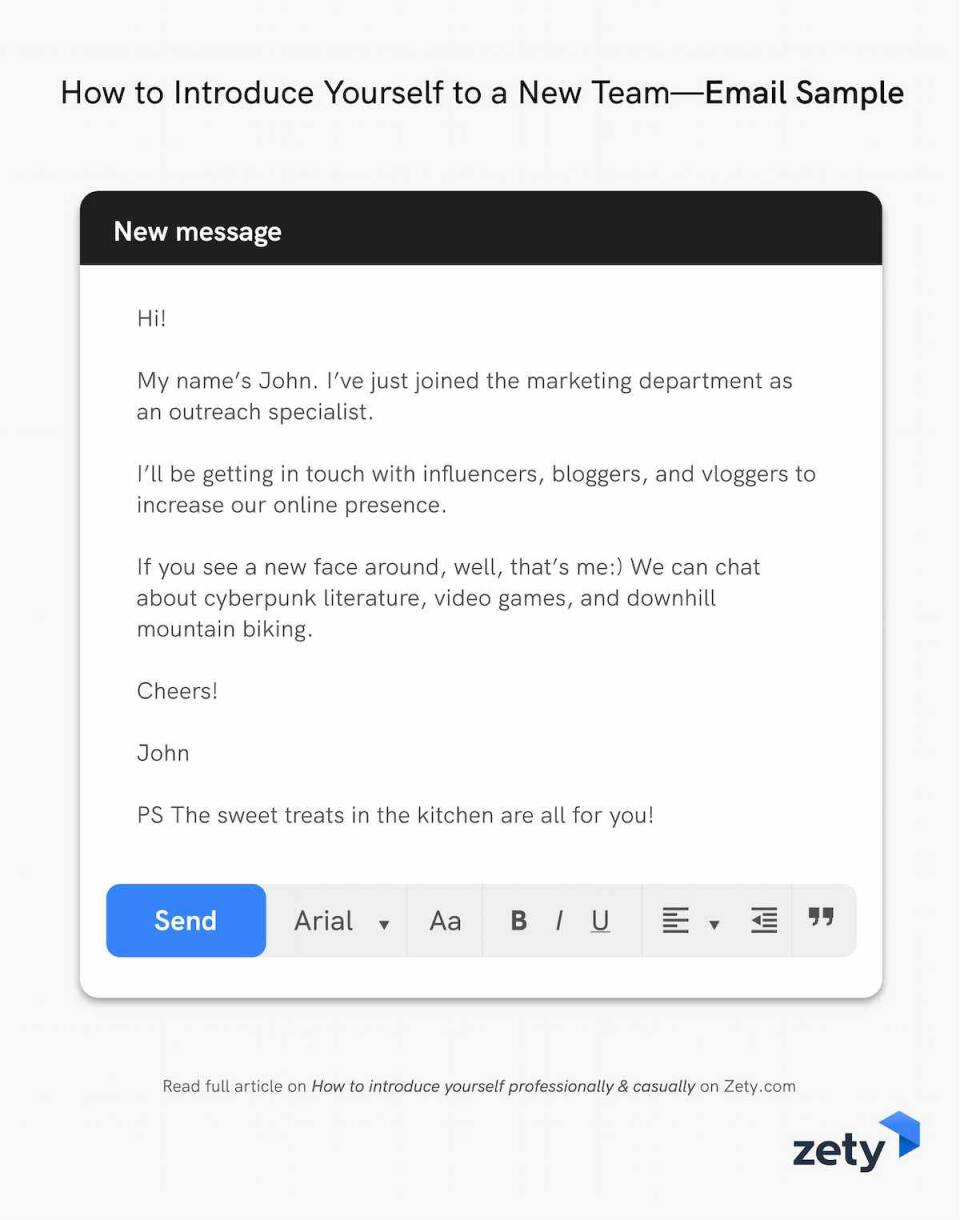
5
Best Way to Introduce Yourself (in Any Setting)
“But I’m about to meet the parents of my 6-year-old daughter’s friends. I’m going to a children’s party!What is the best way to introduce yourself in such a setting?”
Simple—
Be mindful of the context.
If you introduce yourself along these lines:
“My name’s William. I run a company that employs 100+ people. We trade in metal with our partners in China.”
You’ve just made an idiot out of yourself.
How about this:
“I’m Will, Kate’s dad. We like to hang out together at kids’ parties. And... I’m a sucker for chocolate chip cookies.”
Better?
Of course!
Let’s break it down:
The Best Way to Introduce Yourself—Works in Any Setting
- Be mindful of the social context.
Yes, I’m being repetitive. But this is the single most important thing: make your self-introduction relevant.
- Don’t say too much.
Oversharing irrelevant information will play against you. If you’re attending a children’s party, focus on being a parent, and make it the central part of your introduction. You may be the president of a huge company, but there’s no point in bringing this up when introducing yourself.
- Acknowledge the presence of others.
The best introduction focuses on what you have in common with the others. You’ll see how much easier it will be for everyone to establish rapport.
- Listen and be present.
Listening to others is a great interpersonal skill. It’s not exactly part of introducing yourself, but the next step after all introductions are made is striking up a conversation. And great conversations can only happen when people listen to each other and are present in the moment.
Plus, a great cover letter that matches your resume will give you an advantage over other candidates. You can write it in our cover letter builder here. Here's what it may look like:
See more cover letter templates and start writing.
Summary
If you want to introduce yourself in a professional manner remember to be mindful of the social context. In other words, make sure your introduction fits the situation. Plus, be aware of why you're introducing yourself in the first place, and what you want others to learn about you.
Resonate with the audience. Remember: you’re introducing yourself to other human beings, so act like a human yourself. Smile and make eye contact. Focus on what’s relevant—nobody enjoys pointless rambles. So, don’t say too much, avoid verbosity. Be brief and to-the-point.
Last but not least—prepare. Especially if your self-introduction is part of a larger presentation to live audience. And don’t aim for perfection. Just see to it that you've got everything right. Right is enough.
How do you cope with introducing yourself? Do you have your own strategies? Want to share advice or ask a question? We’d love to hear from you. Give us a shout out in the comments below!
